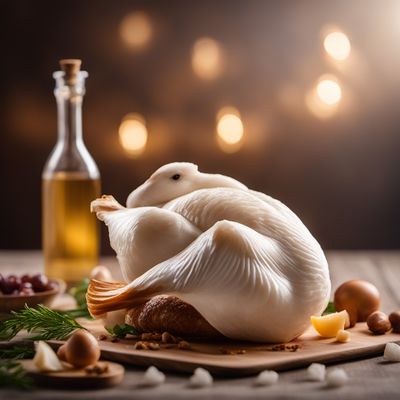
Ingredient
Turkey, fresh fat tissue
The Flavorful Fat: Exploring the Culinary Potential of Fresh Turkey Fat Tissue
Fresh turkey fat tissue is the fatty layer found beneath the skin of a turkey. It has a creamy white color and a soft, pliable texture. When cooked, it renders into a flavorful fat that can be used for sautéing, roasting, or frying. The fat has a mild turkey flavor that enhances the taste of other ingredients while keeping the meat moist and tender. Fresh turkey fat tissue is a prized ingredient in many cuisines around the world, particularly in dishes that require a rich and savory taste.
Origins and history
Turkey has been consumed for centuries and has a rich culinary history. The use of turkey fat in cooking can be traced back to ancient civilizations, where it was highly valued for its flavor and versatility. In many cultures, turkey fat has been used as a cooking medium, similar to other animal fats like lard or duck fat. Today, fresh turkey fat tissue is commonly used in traditional recipes such as confit, pâté, and stuffing, adding a distinct richness to these dishes.
Nutritional information
Fresh turkey fat tissue is primarily composed of fat and provides a concentrated source of calories. It contains both saturated and unsaturated fats, with small amounts of vitamins and minerals. It is important to consume turkey fat in moderation as part of a balanced diet.
Allergens
May contain allergens such as poultry and fat. Individuals with poultry allergies or dietary restrictions should exercise caution when consuming fresh turkey fat tissue.
How to select
When selecting fresh turkey fat tissue, look for pieces that are firm and free from any discoloration or off-putting odors. The fat should have a creamy white color and a smooth texture. If purchasing from a butcher or meat counter, ask for fresh turkey fat tissue that has been recently sourced and stored properly.
Storage recommendations
To maintain the freshness and quality of fresh turkey fat tissue, store it in an airtight container in the refrigerator. It can be kept for up to a week, but it is best to use it as soon as possible for optimal flavor and quality. If you have a large quantity of fresh turkey fat tissue, it can also be frozen for longer storage.
How to produce
Producing fresh turkey fat tissue requires the butchering of a whole turkey. It is recommended to seek guidance from a professional butcher or follow trusted recipes to ensure proper handling and extraction of the fat tissue. Alternatively, fresh turkey fat tissue can be obtained from specialty meat suppliers or online retailers.
Preparation tips
Fresh turkey fat tissue can be rendered into a flavorful cooking fat by gently heating it over low heat until the fat melts and separates from any solids. The rendered fat can be strained and used for sautéing vegetables, frying potatoes, or basting meats. It can also be used as a key ingredient in traditional recipes such as confit or pâté, adding richness and depth of flavor.
Culinary uses
Fresh turkey fat tissue is commonly used in traditional recipes such as confit, pâté, and stuffing. It is also a popular choice for basting and roasting meats, as it adds moisture and flavor to the dish. Additionally, fresh turkey fat tissue can be used as a substitute for other cooking fats in various recipes, providing a unique turkey twist to the final dish.
Availability
Fresh turkey fat tissue is commonly available in butcher shops, specialty meat suppliers, and some well-stocked supermarkets. It may be more readily available during the holiday season or upon special request from the butcher.

